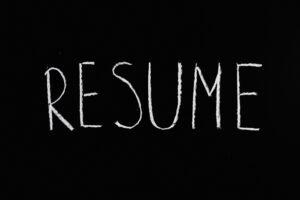Are you using the same resume to apply for internships and jobs that you used to apply to graduate school at Duke? Or are you using a revised resume, but one that is still quite similar. If that’s the case, you’re more than likely not getting the results from your search you hoped for. A pivot to a professional resume can help.
First, a few questions to determine if you need to pivot your resume.

Anna Tarazevich
- Does your resume create the “picture” or story you want the reader to remember?
- Is the resume aligned to a specific role each time you submit it?
- Does your resume have concise, impact stories that demonstrate how you’ll positively contribute in future opportunities?
If you answered no to any of these questions, invest some time in pivoting to a professional resume. Here are 3 tasks to consider in making that pivot.
Target a Specific Role & Audience (yes, we know this is time consuming but it makes a difference)
The field, organization, and role. These three factors give you insight into how your resume should be written (think style, format, keywords, what to share, etc). Using this insight to craft a document customized for the role shows your motivation and your understanding of what is required. General resumes not crafted with a role in mind are easy to ignore.
- This section of the Duke Career Hub helps you think about unique characteristics of fields, organizations, and roles. Use it to begin gathering information about what type of resume and other application documents are expected in your areas of interest.
- Use the job or internship description as your guide for what the reader is seeking. This HBR article can be helpful in understanding job descriptions further.
- Include experiences and skills that are relevant to the role you’re applying for. Adding extra information, and going beyond a 1 page resume for most, dilutes the story you’re trying to tell.
- Look at this customized resume checklist to see if your document is targeted for a specific role.
Create Impact Stories
The best resumes are the ones that show potential impact someone can make in the future roles based on their past and present experience. How do you show this? Through impact stories!
- Check out this resume template created for Engineering Master’s students. On the second page, you’ll see specific information about impact stories and how to create them.
- Think “so what?” This is how we determine if a bullet point in your resume has impact. If there isn’t an answer to the question “so what?” the impact is missing.
- Intentionally choose action verbs start your impact stories. If you need some examples, here are two resources I like to use. Power Verbs from The Muse | Action Verbs from the Duke Career Center
- Be concise. The resume is a communication tool and indicates to the reader how you’ll communicate if they hire you.
Get Feedback
- Connect with a Career Coach to receive feedback on your resume. Share the “picture” or story you’re trying to create with the document and learn how it might be received.
- Ask alumni and industry professionals you have relationships with if they’d be willing to offer feedback. It’s particularly helpful if they work in your area(s) of interest.
- Be prepared to get different, and sometimes conflicting perspectives when asking for feedback. Your job is to sift through the information to determine what is right for you and the fields, organizations, and roles you’re applying to.

